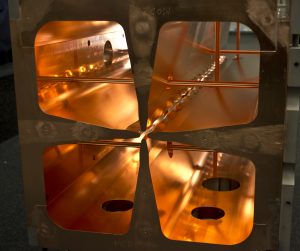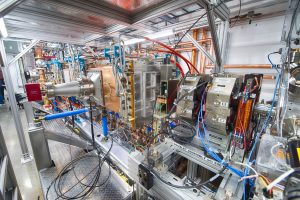
This photo of the RFQ for the Fermilab PIP-II accelerator was taken during the assembly phase at Lawrence Berkeley National Laboratory. Photo courtesy of Andrew Lambert, Berkeley Lab
In March, the Fermilab Accelerator Division successfully sent beam through a newly commissioned linear accelerator. The brand new radio-frequency quadrupole (RFQ) linac, designed and built by a team of engineers and physicists at Lawrence Berkeley National Laboratory, will be the start for a proposed upgrade to Fermilab’s 800-MeV superconducting linear accelerator.
“The RFQ is one of the biggest challenges faced by our group,” said Derun Li, lead scientist on the RFQ development team and deputy head of the Center for Beam Physics at Berkeley Lab. “And seeing it take nearly 100 percent of the source beam on its first try is great!”
The new, front-end accelerator is one of several upgrade projects conducted under PIP-II, a plan to overhaul the Fermilab accelerator complex to produce high-intensity proton beams for the lab’s multiple experiments. PIP-II is supported by the DOE Office of Science.
Currently located at the Cryomodule Test Facility, approximately 1.5 miles northeast of Wilson Hall, the RFQ took first beam – 100-microsecond pulses at 10 hertz – during its first testing phase. Since its first run in March, the team has been working on various commissioning activities, including running the pulsed beam through the RFQ and its transport lines. These activities are expected to continue until June.
The goal of these tests is to provide intense, focused beams to the entire accelerator complex. The lab’s current RFQ, which sits at the beginning of the laboratory’s accelerator chain, accelerates a negative hydrogen ion beam to 0.75 million electronvolts, or MeV. The new RFQ, which is longer, accelerates a beam to 2.1 MeV, nearly three times the energy. Transported beam current, and therefore power, is the key improvement with the new RFQ. The current RFQ delivers 54-watt beam power; the new RFQ delivers beam at 21 kilowatts – an increase by a factor of nearly 400.
RFQs are widely used for accelerating low-energy ion beams, and the energy of the beams they produce typically caps off at about 5 MeV, said Paul Derwent, PIP-II Department head. These low energy protons will then undergo further acceleration by other components of Fermi’s accelerator complex, some to 8 GeV and others to 120 GeV.
The new RFQ is 4.5 meters long and made of four parallel copper vanes, as opposed to four rods used on the current RFQ. As viewed from one end, the vanes form a symmetrical cross. At the center of the cross is a tiny aperture, or tunnel through which the beam travels.
If you were to remove one vane and peer inside the RFQ from the side, you would see an intricate pattern of peaks and valleys, similar to a waveform, along the inner edge of each vane. Like puzzle pieces, the vanes fit together to form the small tunnel with the rippling walls of that inner waveform shape. The farther down the tunnel you go, and therefore the higher the beam energy, the longer the spacing of the peaks and valleys. This means that the time the beam needs to go from peak to valley and back remains constant, necessary for proper acceleration.
Jim Steimel, the electrical engineering coordinator for PIP-II and a Fermilab liaison for Berkeley’s RFQ development team, said this shape is a special trait in RFQs; one that creates an electromagnetic quadrupole field that focuses low-velocity particles.
“As the beam travels through the RFQ tunnel, longitudinal electrical fields generated by the vane peaks and valleys accelerate particle energy,” Steimel said. “This helps focus the beam and keeps the particles accelerating.”
The Berkeley team successfully designed the accelerator to bring beams to a higher intensity than Fermilab’s previous RFQ technology could achieve – energy that matches PIP-II’s front-end requirements.
“Our challenge was to come up with a design that uses minimum radio-frequency power and delivers the required beam quality and intensity, and to engineer a mechanical design that can withstand continuous operation at high average power,” Li said.
Li’s team took into account potential problems that may occur at a power of 100 kilowatts or more, which was needed to maintain the electromagnetic quadrupole field inside the RFQ.
For example, at higher powers temperatures can rapidly increase, causing thermal stress on the RFQ components. Large water flow rates and durable materials are needed to withstand heat and prevent deformations, which is a significant mechanical engineering feat.
“The Berkeley team is proud to have been a key contributor to the first phase of the PIP-II upgrade,” said Wim Leemans, director of Berkeley Lab’s Accelerator Technology and Applied Physics Division. “Berkeley physicists and engineers have been building RFQs for a number of users and purposes for 30 years, and this is a great example of getting the most leverage out of the agency investment.”
Now that the Berkeley and Fermilab teams demonstrated that the RFQ can generate intense beams in pulses, the next step will be to create a continuous high-intensity beam for PIP-II. The team expects to achieve a continuous beam in the summer.
“Fermilab and Berkeley have a long history of collaboration,” Derwent said. “This was just another one where it has worked very well, and their expertise helped us achieve one of our goals.”




